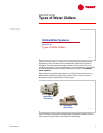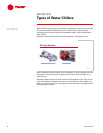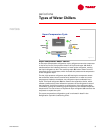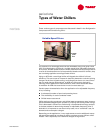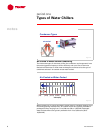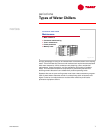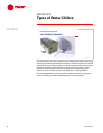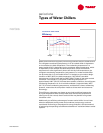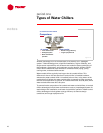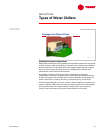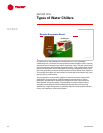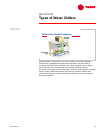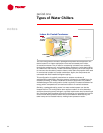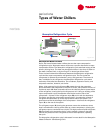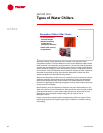
TRG-TRC016-EN 9
period one
Types of Water Chillers
notes
Water-cooled chillers are typically more energy efficient than air-cooled chillers.
The refrigerant condensing temperature in an air-cooled chiller is dependent
on the ambient dry-bulb temperature. The condensing temperature in a
water-cooled chiller is dependent on the condenser-water temperature, which
is dependent on the ambient wet-bulb temperature. Since the wet-bulb
temperature is often significantly lower than the dry-bulb temperature, the
refrigerant condensing temperature (and pressure) in a water-cooled chiller
can be lower than in an air-cooled chiller. For example, at an outdoor design
condition of 95°F [35°C] dry-bulb temperature, 78°F [25.6°C] wet-bulb
temperature, a cooling tower delivers 85°F [29.4°C] water to the water-cooled
condenser. This results in a refrigerant condensing temperature of
approximately 100°F [37.8°C]. At these same outdoor conditions, the refrigerant
condensing temperature in an air-cooled condenser is approximately 125°F
[51.7°C]. A lower condensing temperature, and therefore a lower condensing
pressure, means that the compressor needs to do less work and consumes
less energy.
This efficiency advantage may lessen at part-load conditions because the
dry-bulb temperature tends to drop faster than the wet-bulb temperature
(see Figure 12). As a result, the air-cooled chiller may benefit from greater
condenser relief.
Additionally, the efficiency advantage of a water-cooled chiller is much less
when the additional cooling tower and condenser pump energy costs are
considered. Performing a comprehensive energy analysis is the best method
of estimating the operating-cost difference between air-cooled and water-cooled
systems.
air-cooled or water-cooled
Efficiency
outdoor temperature
outdoor temperature
12
12
midnight
midnight
12
12
noon
noon
12
12
midnight
midnight
dry bulb
dry bulb
wet bulb
wet bulb
Figure 12



